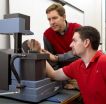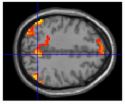(Press-News.org) Mount Sinai researchers coordinating the largest clinical study to date of "Sarcoid Like" Granulomatous Pulmonary Disease in World Trade Center (WTC) responders have found that the rate of the condition was increased in this group as compared to the records of pre-9/11 FDNY personnel. The study is published online in the American Journal of Industrial Medicine.
The Mount Sinai researchers studied almost 20,000 responders who had an initial exam in the Mount Sinai World Trade Center Medical Monitoring and Treatment Program between July 2002 and September 2007. Overall rates of "Sarcoid Like" Granulomatous Pulmonary Disease were elevated and peaked with an incidence rate of 54 cases per 100,000 between the years 2003 and 2004. Previous studies of pre-9/11 FDNY personnel showed an average yearly rate of 15 cases per 100,000. In addition, patients with the disease had lung function abnormalities consistent with prior studies of WTC responders. Similar findings have also been reported by two other cohort studies, the Fire Department of New York City (Izbicki et al. 2007) and the World Trade Center Registry (Jordan HT et al. 2008).
"More than 50,000 men and women were exposed to products of combustion and particulate matter following the September 11th attacks," said the study's lead author Laura Crowley, MD, Assistant Professor, Preventive Medicine, Mount Sinai School of Medicine.
"Our findings support the hypothesis that environmental exposures generated by the destruction of the World Trade Center may cause 'Sarcoid Like' Granulomatous Pulmonary Disease. The screening and monitoring of all WTC responders, including periodic chest radiography and spirometry, must continue so that the population's medical issues may be optimally addressed by identifying and treating diseases in their earlier stages," she said.
Like sarcoidosis, "Sarcoid Like" Granulomatous Pulmonary Disease appears to be a multisystem disease that causes inflammation in one or more organs, including the lungs, skin and lymph nodes. Although the cause of "Sarcoid Like" Granulomatous Pulmonary Disease is unknown, it has been associated with multiple environmental and occupational exposures.
"The results of this study clearly supports the critical need for ongoing long-term
monitoring and treatment for WTC responders," said Philip Landrigan, MD, Principal Investigator of the Mount Sinai WTC Program's Data and Coordination Center, Dean of Global Health and Chair of the Department of Preventive Medicine, Mount Sinai School of Medicine.
"Providing health care for WTC-related illnesses and disease is the least we can do, not only for this study population, but all those whose health has been affected by 9/11. Our 9/11 heroes have given so much in their endeavors to help our country when their labor was required," he said.
The World Trade Center Medical Monitoring and Treatment Program with funding from the federal government, offers free, confidential medical and mental health evaluation, long-term monitoring and treatment for eligible WTC rescue, recovery and clean-up workers, including volunteers, who responded to the Sept. 11th, 2001 terrorist attacks in NYC. Medical screening and annual medical monitoring examinations, as well as both out- and in-patient treatment services as may be needed for WTC-related medical and mental health conditions is being offered at a number of NY/NJ metro-area occupational medicine clinical centers and nationwide. Mount Sinai Center for Occupational & Environmental Medicine, Mount Sinai School of Medicine, has taken a lead in developing the program that stands as the federal government's principal public health response to 9/11 and continues to coordinate the NY-NJ Consortium of occupational medicine providers of program services.
The Program also maintains data through two Data and Coordination Centers, one coordinated by Mount Sinai (School of Medicine) and one by the FDNY, complementing the latter agency's matching service program for current and retired NYC Fire Dept. employees. Non-identifying data is periodically pooled and analyzed across the programs to expand the scientific understanding of health impacts resultant from WTC exposures, assure best practices of care for responders in need, and help inform future health response to such emergencies.
The Program's Mount Sinai-coordinated Consortium of Clinical Centers of Excellence have medically screened over 30,000 WTC rescue and recovery workers and volunteers in all 50 states to date, since the program kicked off in July of 2002. The Consortium has also provided over 66,000 medical monitoring exams.
###
To determine eligibility, to enroll and/or for more information, WTC responders nationwide need only call into the programs hotline at 1-888-702-0630. The program maintains a website as well, at wtcexams.org, which also lists participating services providers and clinical center locations, including those maintained by a NY/NJ metro-area Consortium.
About The Mount Sinai Medical Center
The Mount Sinai Medical Center encompasses both The Mount Sinai Hospital and Mount Sinai School of Medicine. Established in 1968, Mount Sinai School of Medicine is one of few medical schools embedded in a hospital in the United States. It has more than 3,400 faculty in 32 departments and 15 institutes, and ranks among the top 20 medical schools both in National Institute of Health funding and by U.S. News & World Report. The school received the 2009 Spencer Foreman Award for Outstanding Community Service from the Association of American Medical Colleges.
The Mount Sinai Hospital, founded in 1852, is a 1,171-bed tertiary- and quaternary-care teaching facility and one of the nation's oldest, largest and most-respected voluntary hospitals. U.S. News & World Report consistently ranks The Mount Sinai Hospital among the nation's best hospitals based on reputation, patient safety, and other patient-care factors. Nearly 60,000 people were treated at Mount Sinai as inpatients last year, and approximately 530,000 outpatient visits took place.
For more information, visit www.mountsinai.org. Follow us on Twitter @mountsinainyc.
END
Spartanburg, S.C., USA, 6 January, 2010 – Researchers at Wofford College discovered that a Border Collie comprehends the names of over 1000 objects, differentiating between names of objects and orders to fetch them. This research deepens the findings of researchers in Germany, who had discovered a dog that knew the names of a couple of hundred objects. Important questions were left open as to how far a dog could go, and whether the dog really understood that the object names were nouns and not commands to retrieve the object.
John Pilley and Alliston Reid answered two ...
The Moon, Earth's closest neighbor, has long been studied to help us better understand our own planet. Of particular interest is the lunar interior, which could hold clues to its ancient origins. In an attempt to extract information on the very deep interior of the Moon, a team of NASA-led researchers applied new technology to old data. Apollo seismic data was reanalyzed using modern methodologies and detected what many scientists have predicted: the Moon has a core.
According to the team's findings, published Jan. 6 in the online edition of Science, the Moon possesses ...
Show enthusiasm, ask questions and bring copies of a resume. These are just a handful of the most common interview tips for job seekers, but a person's posture may also be a deciding factor for whether they land a coveted position – even when the person on the other side of the desk is in a more powerful role.
According to new research from the Kellogg School of Management at Northwestern University, posture plays an important role in determining whether people act as though they are really in charge. The research finds that "posture expansiveness," or positioning oneself ...
Ibn al-Haytham's 11th-century Book of Optics, which was published exactly 1000 years ago, is often cited alongside Newton's Principia as one of the most influential books in physics. Yet very little is known about the writer, considered by many to be the father of modern optics.
January's Physics World features a fanciful re-imagining of the 10-year period in the life of the medieval Muslim polymath, written by Los Angeles-based science writer Jennifer Ouellette.
The feature covers the time when al-Haytham -- banished from society and deprived of books -- came up with ...
COLUMBUS, Ohio – Young people may crave boosts to their self-esteem a little too much, new research suggests.
Researchers found that college students valued boosts to their self-esteem more than any other pleasant activity they were asked about, including sex, favorite foods, drinking alcohol, seeing a best friend or receiving a paycheck.
"It is somewhat surprising how this desire to feel worthy and valuable trumps almost any other pleasant activity you can imagine," said Brad Bushman, lead author of the research and professor of communication and psychology at The ...
AMES, Iowa – Michael Kessler has worked with polymers that repair themselves when they crack. And he's worked with polymers made from vegetable oils. Now he's working to combine the two technologies.
Kessler, an Iowa State University associate professor of materials science and engineering and an associate of the U.S. Department of Energy's Ames Laboratory, is researching and developing biorenewable polymers capable of healing themselves as they degrade and crack.
"If successful, the results of this research will provide biorenewable alternatives to petroleum-based ...
VIDEO:
Extracting mitochondria from a human cell (larger object on bottom right) is a tricky process. NIST researchers recently developed techniques that can surgically remove these tiny cellular engines, potentially enabling...
Click here for more information.
Medical researchers who crave a means of exploring the genetic culprits behind a host of neuromuscular disorders may have just had their wish granted by a team working at the National Institute of Standards and Technology ...
Brain scans of children with attention-deficit/hyperactivity disorder (ADHD) have shown for the first time why people affected by the condition sometimes have difficulty in concentrating. The study, by experts at The University of Nottingham, may explain why parents often say that their child can maintain concentration when they are doing something that interests them, but struggles with boring tasks.
Using a 'Whac-a-Mole' style game, researchers from the Motivation, Inhibition and Development in ADHD Study (MIDAS) group found evidence that children with ADHD require ...
Is the expansion of the universe accelerating for some unknown reason? This is one of the mysteries plaguing astrophysics, and somewhere in distant galaxies are yet-unseen supernovae that may hold the key. Now, thanks to a telescope calibrated by scientists from the National Institute of Standards and Technology (NIST), Harvard University and the University of Hawaii, astrophysicists can be more certain of one day obtaining an accurate answer.
The NIST scientists traveled to the summit of Haleakala volcano in Hawaii to fine-tune the operation of billions of light-collecting ...
As the day draws nearer for the world to run out of the unique addresses that allow us to use the Internet—now predicted to happen by the end of 2012—researchers at the National Institute of Standards and Technology (NIST) have issued a guide for managers, network engineers, transition teams and others to help them deploy the next generation Internet Protocol (IPv6) securely.
Guidelines for the Secure Deployment of IPv6 (NIST Special Publication 800-119), describes the features of IPv6 and the possible related security impacts, provides a comprehensive survey of mechanisms ...



